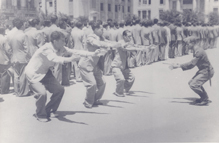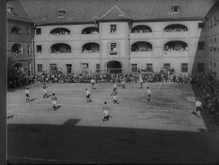
Sport in the Thessaloniki ghetto. Greece, 1942.

Images taken from the album of reels from a propaganda film shot in the Terezín ghetto by Kurt Gerron, a Jewish actor and director, at the request of camp commander Hans Günther.
Book our events online
« sport », persecution
and annihilation
Initially a common practice, permitted in the first concentration camps and ghettos, sport was transformed by the Nazis into a form of torture, to be used in the death camps. Effectively, in Nazi terminology, the term “sport” had fatal implications: the hunting, physical humiliation or killing of defenseless Jews.
During the first phase of concentration camps like Dachau, Buchenwald and Poniatowa, political deportees and prisoners of war were allowed to practice sports, as well as other activities (theatre, music, lectures). Similarly, in the ghettos of Lodz and Warsaw, the inhabitants organized gymnastics sessions to provide a sense of relative normality and freedom. Sports were also featured in propaganda films, intended to show how fairly the prisoners were being treated.
At Westerbork camp in the Netherlands, a Jewish prisoner was asked to operate the camera, at the director's request. When the Red Cross visited Terezín (Theresienstadt) in 1944, a game of football was even organized among the in-mates.
In the ghettos, the captors sometimes used physical exercises to bully and humiliate the inhabitants: gymnastics sessions on the floor, amid the muddy streets of Warsaw; in Thessaloniki, flexing the knees with arms stretched forward until exhaustion set in; or even human horse-races at Minsk, under a barrage of jeering.
Sport took on extreme forms in the death camps: at Belzec, several football matches were witnessed between the SS and the Totenjüden (Jews who carried the dead to the furnaces), and at Auschwitz between the Sonderkommandos (Jews forced into slave labor) and the SS. If a Jewish champion was recognized, they were often humiliated, and subjected to « sporting » punishments. Thanks to his extraordinary physical resilience, world swimming champion Alfred Nakache survived the SS's games at Auschwitz: he was made to fetch keys and stones from the bottom of a tank of stagnant, icy water.
Some of them remain famous as Young Perez murdered January 22, 1945 during the death marches. As he was, many Jewish champions were victims of the Holocaust. Next >>
quizz In which camp a propaganda film was made for the Red Cross? Terezin Westerbork
